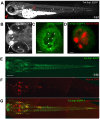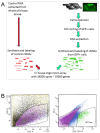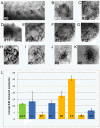Transcriptional signature of accessory cells in the lateral line, using the Tnk1bp1:EGFP transgenic zebrafish line
- PMID: 22273551
- PMCID: PMC3305402
- DOI: 10.1186/1471-213X-12-6
Transcriptional signature of accessory cells in the lateral line, using the Tnk1bp1:EGFP transgenic zebrafish line
Abstract
Background: Because of the structural and molecular similarities between the two systems, the lateral line, a fish and amphibian specific sensory organ, has been widely used in zebrafish as a model to study the development/biology of neuroepithelia of the inner ear. Both organs have hair cells, which are the mechanoreceptor cells, and supporting cells providing other functions to the epithelium. In most vertebrates (excluding mammals), supporting cells comprise a pool of progenitors that replace damaged or dead hair cells. However, the lack of regenerative capacity in mammals is the single leading cause for acquired hearing disorders in humans.
Results: In an effort to understand the regenerative process of hair cells in fish, we characterized and cloned an egfp transgenic stable fish line that trapped tnks1bp1, a highly conserved gene that has been implicated in the maintenance of telomeres' length. We then used this Tg(tnks1bp1:EGFP) line in a FACsorting strategy combined with microarrays to identify new molecular markers for supporting cells.
Conclusions: We present a Tg(tnks1bp1:EGFP) stable transgenic line, which we used to establish a transcriptional profile of supporting cells in the zebrafish lateral line. Therefore we are providing a new set of markers specific for supporting cells as well as candidates for functional analysis of this important cell type. This will prove to be a valuable tool for the study of regeneration in the lateral line of zebrafish in particular and for regeneration of neuroepithelia in general.
Figures





Similar articles
-
Fluorescent activated cell sorting (FACS) combined with gene expression microarrays for transcription enrichment profiling of zebrafish lateral line cells.Methods. 2013 Aug 15;62(3):226-31. doi: 10.1016/j.ymeth.2013.06.005. Epub 2013 Jun 19. Methods. 2013. PMID: 23791746 Free PMC article.
-
Phoenix is required for mechanosensory hair cell regeneration in the zebrafish lateral line.PLoS Genet. 2009 Apr;5(4):e1000455. doi: 10.1371/journal.pgen.1000455. Epub 2009 Apr 17. PLoS Genet. 2009. PMID: 19381250 Free PMC article.
-
Characterization of a nap1l1 transgenic reporter in zebrafish.Gene. 2020 Apr 20;735:144388. doi: 10.1016/j.gene.2020.144388. Epub 2020 Jan 24. Gene. 2020. PMID: 31987905
-
Sensory hair cell regeneration in the zebrafish lateral line.Dev Dyn. 2014 Oct;243(10):1187-202. doi: 10.1002/dvdy.24167. Epub 2014 Aug 14. Dev Dyn. 2014. PMID: 25045019 Free PMC article. Review.
-
The genetics of hair-cell function in zebrafish.J Neurogenet. 2017 Sep;31(3):102-112. doi: 10.1080/01677063.2017.1342246. Epub 2017 Jul 13. J Neurogenet. 2017. PMID: 28705044 Free PMC article. Review.
Cited by
-
Cisplatin exposure acutely disrupts mitochondrial bioenergetics in the zebrafish lateral-line organ.Hear Res. 2022 Dec;426:108513. doi: 10.1016/j.heares.2022.108513. Epub 2022 May 7. Hear Res. 2022. PMID: 35534350 Free PMC article.
-
NIDCD's 5-Year Strategic Plan Describes Scientific Priorities and Commitment to Basic Science.J Assoc Res Otolaryngol. 2023 Jun;24(3):265-268. doi: 10.1007/s10162-023-00902-5. J Assoc Res Otolaryngol. 2023. PMID: 37341886 Free PMC article.
-
Identification of sensory hair-cell transcripts by thiouracil-tagging in zebrafish.BMC Genomics. 2015 Oct 23;16:842. doi: 10.1186/s12864-015-2072-5. BMC Genomics. 2015. PMID: 26494580 Free PMC article.
-
How Zebrafish Can Drive the Future of Genetic-based Hearing and Balance Research.J Assoc Res Otolaryngol. 2021 Jun;22(3):215-235. doi: 10.1007/s10162-021-00798-z. Epub 2021 Apr 28. J Assoc Res Otolaryngol. 2021. PMID: 33909162 Free PMC article. Review.
-
Expression patterns of activating transcription factor 5 (atf5a and atf5b) in zebrafish.Gene Expr Patterns. 2020 Sep;37:119126. doi: 10.1016/j.gep.2020.119126. Epub 2020 Jul 11. Gene Expr Patterns. 2020. PMID: 32663618 Free PMC article.
References
Publication types
MeSH terms
Substances
Associated data
- Actions
Grants and funding
LinkOut - more resources
Full Text Sources
Molecular Biology Databases
Miscellaneous

